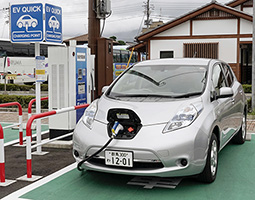
Plugging in a charging cable 
Charging using an “EV Quick” (see sign) rapid charger installed in the parking lot of a grocery store. Using the rapid charger, electric vehicle (EV) charging can be completed in 30 to 40 minutes while shopping.
March 2021
The Popularization of "Next-Generation Vehicles"

Japan is promoting the reduction of CO2 emissions through the popularization of energy-efficient cars as a measure against global warming.

Based on the Paris Agreement that was adopted at COP21 in 2015, a variety of measures against global warming are progressing in Japan. Among them, expectations are rising for the transition to cars with a low environmental burden as they will greatly contribute to a reduction in carbon dioxide emissions. Around 86% (2018) of emissions in the transport sector in Japan are produced by cars.
In 2010, the Government of Japan’s Ministry of Economy, Trade and Industry (METI) announced the Next-Generation Vehicle Strategy 2010, in which it set goals for popularization of such vehicles in 2020 and 2030, and defined five types of “next-generation vehicles”: hybrid electric vehicles that combine a gasoline or other fuel engine with an electric motor; plug-in hybrid electric vehicles that can be charged externally; battery electric vehicles; fuel-cell electric vehicles that generate power from hydrogen and oxygen in the air; and clean diesel vehicles.
The four types of vehicles other than clean diesel vehicles are collectively called “electrified vehicles,” and METI aims for the popularization of these cars among ordinary users.
In December 2020, the Green Growth Strategy towards 2050 Carbon Neutrality was announced, in which a new goal was established: to make all new cars sold in Japan electrified vehicles by the mid 2030s. Accepting this shift, the automotive industry is entering into a once-in-a-century revolution.
Development of environment-friendly battery electric vehicles, which are prominent among the next-generation vehicles today, began in earnest after a Zero Emission Vehicle bill limiting the sales of internal combustion vehicles was established in the state of California in the United States in 1990.
Ogino Norikazu of the Next Generation Vehicle Promotion Center says, “Japanese battery electric vehicles have led the world in terms of driving range and top speed, featuring Permanent Magnet Synchronous Motors (PMSM) and more. The lithium-ion battery, invented by the winner of the Nobel Prize in Chemistry Yoshino Akira and his team, allows for a large storage volume in a compact size, greatly improving on conventional lead batteries, and this invention alone increased the practicality of battery electric vehicles.”
In 1997, sales of the world’s first mass-produced hybrid electric vehicle began in Japan. Later, development of unique technologies was undertaken, including the development of cars that could use their batteries as a source of power for home appliances. The need for this power source was strongly recognized from the large-scale blackouts that occurred with the Great East Japan Earthquake in 2011. The range of uses are expanding, with electrified vehicles being used as a power source for homes during disasters and in emergency situations, as a way to directly supply power to home electronics, and as a power source for outdoor activities.
Battery functionality has improved over the last ten years for battery electric vehicles, and there are some cars that have been produced that can drive more than 500 km on a full charge, attaining a driving range comparable to internal combustion vehicles. Public charging facilities, which will be necessary with the popularization of electric cars, are being expanded through a governmental subsidy system, and even now, more than 7,700 such facilities have been installed across Japan. At the same time, development of fuel-cell electric vehicles, said to be suited to longer distance driving and for larger vehicles, and infrastructure improvements are also progressing, preparing the stage for the popularization of next-generation vehicles.

There are currently (as of end March, 2020) more than 10.26 million electrified vehicles in Japan (about 10 million hybrid electric vehicles and about 260,000 non-hybrid vehicles).
Ogino says, “We are in the initial stages of the popularization of non-hybrid electric vehicles, but the conditions in which these cars can be used are now in place. Moving forward, it is necessary for everyone to learn more about electrified vehicles’ performance and the state of infrastructure improvements to become able to consider the switch to electrified vehicles, and it is also necessary to increase functionality and lower the price while also further increasing battery performance.”
Switching to a next-generation vehicle that greatly reduces our burden on the environment is clearly one thing we can do as a measure against global warming. Cars are an essential partner in life as a means of transport, and next-generation vehicles will lead to major changes not only for each user but to overall societal awareness, as well.

